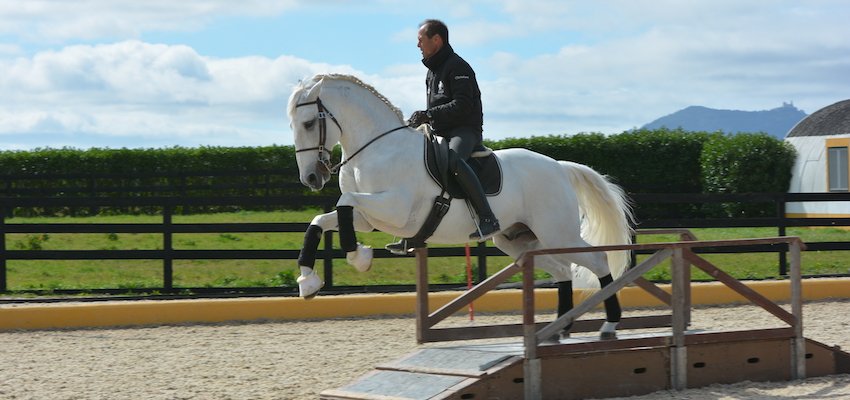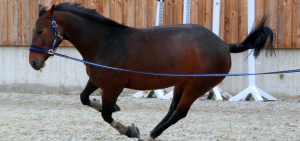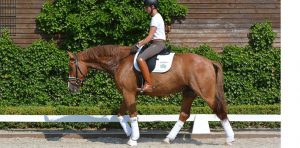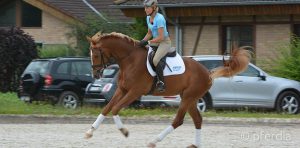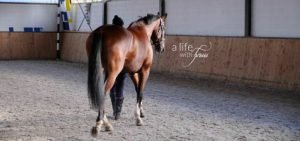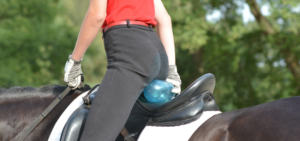The speed trial is the final test during Working Equitation individual competitions and the next to last in team competitions. It is thrilling to watch a great horse and rider win this portion of the competition because it takes hard work for both. It can also be a great training exercise to use at home even if you never plan on competing in a Working Equitation competition as it will teach you to rely on your horse, keep both your minds active and help with balance. Horses love feeling like they have a job to do and conquering the Working Equitation obstacles gives them that feeling. At the beginning levels working on the speed test helps with bending, leg yields and transitions. At the higher levels, it helps with collection and balance. It can also be a great training exercise if you love to take your horse on an occasional trail ride.
Summary
- The Speed Trial Obstacles in Working Equitation
- Speed Trial Disqualifications
- Speed Penalities
- Competitive Levels of Working Equitation Obstacles
- Getting Started
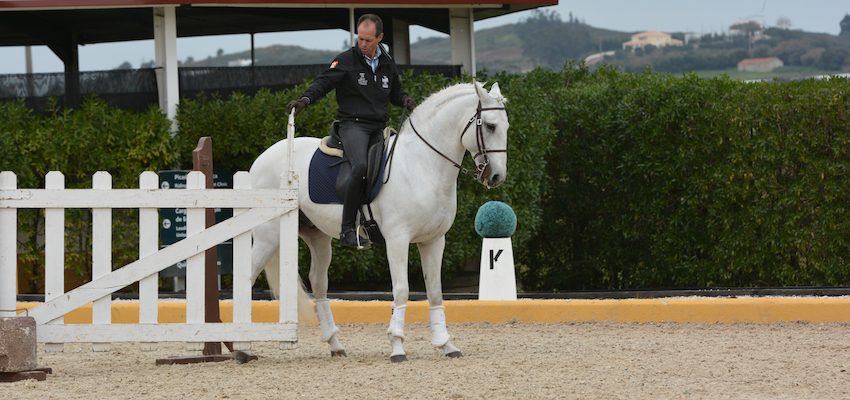
What Working Equitation Obstacles Are Included in a Speed Test?
There are 23 Working Equitation obstacles that may be used. Not all Working Equitation obstacles will be present on every course, and there is no definitive way that the obstacles must be arranged.
The Working Equitation obstacles are:
- Gate – During this obstacle, the horse and rider must approach perpendicular to the gate. The rider must open the gate and maintain contact with it. Then, they must pass through the gate, and the rider must secure the gate in its original manner.
- Reinback “L” – The horse and rider must enter this obstacle with the red flag on their right and the white flag on their left. Then, the rider must ring a bell or retrieve a cup from a cup before backing through the obstacle. If a cup is used, then the cup must be returned to its original position.
- Bank – This Working Equitation obstacle consists of a natural substance embankment that is not more than 2-feet tall with a flat top that measures 6.5-feet-long in the direction of travel. The Working Equitation obstacle can contain both and upward and downward slope. The horse should pass over the obstacle as quickly as possible.
- Bell Corridor – This Working Equitation obstacle consists of two parallel fences that are at least 12 feet long. The horse and rider must enter the obstacle so that the rider can ring a bell at the far end of the obstacle before the horse backs out of the obstacle.
- Drums – This Working Equitation obstacle consists of three barrels or similar objects. The rider must guide their horse to the first barrel and make a full circle around it to the right. Then, head to barrel two at the canter. The horse must change leads at the midway point. The horse circles the second barrel and changes leads on the way at the midway point on the way to the third barrel. Finally, the horse and rider must return to the starting point.
- Figure 8 – The horse and rider will come up to two barrels where the center is 10-feet apart. The horse and rider will pass through the middle of the two barrels and circle the right drum. When they get back to the middle, they change leads or bends and circle the left barrel.
- Jump – This Working Equitation obstacle can be used once in each direction on the course. The horse must jump cleanly over the obstacle.
- Pen – The horse and rider must ride around the pen that contains small animals or replicas of small animals. During the speed trial, the horse only needs to circle the pen in one direction.
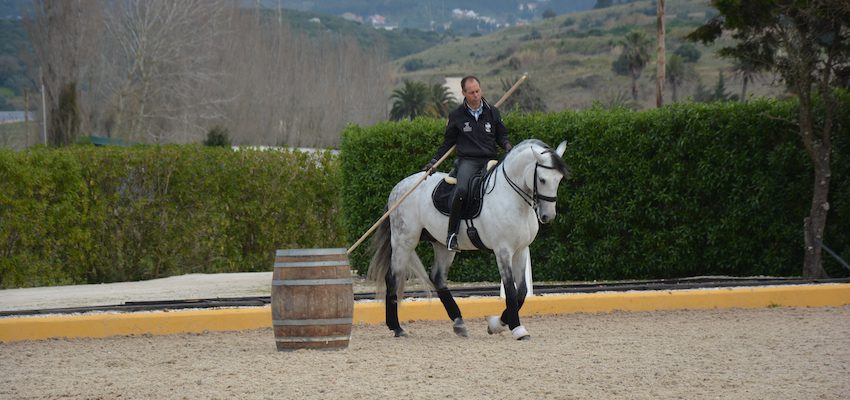
- Replace Pole – The rider must place a pole into a barrel so that it does not bounce out while completely circling the barrel.
- Remove Pole – The horse must completely circle the barrel once before the rider removes the pole. This Working Equitation obstacle must be performed without breaking gait.
- Water – This Working Equitation obstacle requires the rider to go through a water-filled ditch without breaking gait. A log can be placed before or after the ditch.
- Rounding Posts – This is one of the most complicated Working Equitation obstacles for inexperienced riders to master. The obstacle consists of six poles with three poles on each side. The horse and rider must enter the obstacle and go around the middle pole on the same side that they will retrieve the cup. Then, the pair must back through the obstacle rounding the pole again before depositing the cup on the same side of the obstacle that it was originally on in the beginning.
- Ridepass Rail – This Working Equitation obstacle can be done with from one to three poles placed in various patterns. The horse and rider approach perpendicular to the obstacle. Then, the horse must maneuver through the obstacle keeping the pole between their front and hind legs.
- Spear Ring – Used in combination with a remove post obstacle, the rider must remove the pole from the barrel and spears a ring. During the speed test, there is no penalty if they miss, but they get a 10-point bonus if they successfully spear the ring.
- Double Slalom – This Working Equitation obstacle helps riders and horses work on their correct leads and collection because changing leads is required often. Five to seven poles are set up in two straight lines. Flags are attached to the top of the pole to tell riders which direction they must go around the poles. The horse must change leads halfway between the poles.
- Single Slalom – One line of five poles is used for this event. The horse must change leads or bends as they weave in and out of the poles.
- Switch Cup – With this Working Equitation obstacle, two poles are set up perpendicular to each other. A cup is placed on top of one of the poles. The rider must halt their horse between the two poles and move the cup to the other one.
- Bridge – A bridge may be used as an obstacle twice in a course as long as it is approached from different directions.
Speed Trial Disqualifications
You need to be aware of the things that can disqualify you during a Working Equitation Obstacles speed trial competition. Many of them may sound very familiar if you have participated in jumping events. You cannot go off course, knocking down an obstacle that you have not yet completed and not correcting a mistake that you or your horse has made during the trial.
Other rules, however, are precise to Working Equitation Obstacles competition:
- Failure to advance for 15 seconds
- Passing through the Working Equitation Obstacles course entry and exit markers, except when beginning or exiting a course
- Failure to retrieve a dropped item and complete the obstacle
- Stroking the horse or touching it three times in front of the rein hand during a Working Equitation Obstacles course
- Failure to contact the water with at least one foot at a water obstacle during a Working Equitation Obstacles speed trial
- Switching hands used to perform different tasks throughout a Working Equitation Obstacles course
How does speed penalties work?
Generally, the fastest horse and rider combination wins the Working Equitation Obstacles speed test, but a handful of penalties will get time added to your Working Equitation Obstacles completion time. These include:
- Thirty seconds is added to the time if you do not latch the gate in the prescribed manner
- Ten seconds for knocking over or dislodging Working Equitation Obstacles
- Ten seconds for failing to salute the judge
- Five seconds for putting the wrong end of the pole in the barrel
- Five seconds for skewering the ring with the butt end of the pole
- Five seconds for any leg stepping over a side pass pole
- Five seconds for the first and second time you stroke the horse in front of the rein hand
What are the Different Competitive Levels of Working Equitation Obstacles?
Just like with dressage, there are many levels that you can advance to with speed testing. Children have their own level, and they compete against each other.
If you are an adult, you will start at the introductory level, which lets you perform most of the Working Equitation at a walk or trot. After that, you will become a Novice A, Novice B, Intermediate A, Intermediate B, and Advanced. By the time that you reach the Master’s level, you can only touch the reins with one hand.
How to Get Started?
If Working Equitation Obstacles sounds like something you would like to do, then take a look at Pedro Torres. He demonstrates the basics and introduces you to the various obstacles of Working Equitation.

